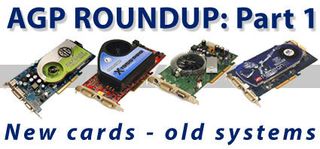AGP Platform Analysis, Part 1: New Cards, Old System
AGP Roundup, Part 1: New Cards, Old Systems

If you've ever paid any attention to a forum where graphics cards are discussed, you'll notice that inevitably there will be a number of threads where people will argue about whether or not it's worthwhile it to stick a new AGP card into an older PC. Some argue that the CPU of the older system will hold the newer card back from reaching its potential. Others will claim that the video card is more of a bottleneck than the CPU when it comes to gaming, so large gains will be seen if the video card is upgraded even though the platform is aging. Still others will say that even though you might see a performance increase with a new AGP video card, it's probably more cost effective to scrap the old AGP motherboard in favor of a new PCI Express (PCIe) motherboard.
The release of ATI's newer X1950 PRO in an AGP flavor has really made these arguments come to the fore front. Sure, it's probably the most powerful AGP card on the planet, but is it wise to invest in an AGP card at this time, with DirectX 10 around the corner, and an old CPU that might be bottlenecking the card anyway?
We thought it would be a good idea to run some experiments, to see if it's worth it to upgrade that old AGP system with a new card, or if the money's better spent moving on to greener PCI Express pastures.
In this first article, we're going to start by benchmarking all the newest, most powerful AGP cards on an Athlon XP 2500+. This system should be representative of many older Athlon XP systems out there, and would probably give a fair approximation of older Pentium 4 2.5 GHz performance as well.
So, that's our agenda; now, let's have a look at the combatants!
Join our discussion on this topic
Stay on the Cutting Edge
Join the experts who read Tom's Hardware for the inside track on enthusiast PC tech news — and have for over 25 years. We'll send breaking news and in-depth reviews of CPUs, GPUs, AI, maker hardware and more straight to your inbox.
Current page: AGP Roundup, Part 1: New Cards, Old Systems
Next Page The New AGP LineupMost Popular


